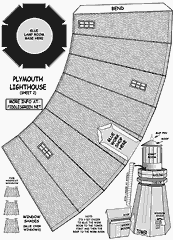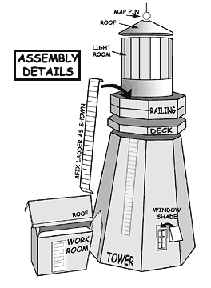

Plymouth, MA - $$4.95
Plymouth Lighthouse, Plymouth Mass, or Gurnet Point, lighthouse, situated on the north side of the entrance to Plymouth Bay, easily survived the Revolution and apparently performed its job throughout that conflict, despite having been near the scene of a battle between a nearby fort and a British frigate and having been struck by a stray cannon ball. The state repaired the war damage in 1783, and in 1790 turned the light station over to the central government.
Plymouth Lighthouse, Plymouth, MA
 Plymouth Lighthouse, Plymouth Mass, or Gurnet Point, lighthouse, situated on the north side of the entrance to Plymouth Bay, easily survived the Revolution and apparently performed its job throughout that conflict, despite having been near the scene of a battle between a nearby fort and a British frigate and having been struck by a stray cannon ball. The state repaired the war damage in 1783, and in 1790 turned the light station over to the central government.
Plymouth Lighthouse, Plymouth Mass, or Gurnet Point, lighthouse, situated on the north side of the entrance to Plymouth Bay, easily survived the Revolution and apparently performed its job throughout that conflict, despite having been near the scene of a battle between a nearby fort and a British frigate and having been struck by a stray cannon ball. The state repaired the war damage in 1783, and in 1790 turned the light station over to the central government.
The original lighthouse consisted of two beacons, one at either end of a small building. One of the twin towers was later taken down in 1924. Its 39-foot mate still remains, flashing every 30 seconds.
Plymouth Lighthouse
THE HISTORIC PLYMOUTH LIGHTHOUSE occupies a thumb-like projection of land near the entrance of Plymouth Harbor about thirty miles south of Boston and was constructed more than a decade before the Declaration of Independence was signed in Philadelphia
Although this flat point of land, called the Gurnet by local residents, is today crowded with fine seaside homes, it was once a lonely, desolate peninsula far from human habitation.
The first light was built in 1769, nearly 150 years after the Pilgrims, sailing from England aboard the Mayflower, initially settled around Plymouth Harbor. The original lighthouse consisted of two beacons, one at either end of a small building. It had the unusual distinction of having been hit by a British cannonball during the American Revolution, although the light was miraculously undisturbed.
When the revolution was over, the lighthouse was ceded from Massachusetts to the new federal government. Its tradition of having two lights at the point persisted into the 19th century in order to avoid confusion with other nearby lights. At least two replacement structures also contained a pair of beacons. The last two-beacon edifice was raised in 1843, although one of the twin seconds.
Although one of the twin towers was later taken down in 1924. Its 39-foot mate still remains, flashing every 30 seconds.
A legend survives about an old sea captain (who didn't survive) and how he only appears in the moments of darkness between the blinks of light every 30 seconds. He is believed to occasionally offer unsolicited advice to visitors who are encouraged to follow it or suffer from a similar demise.
Fire consumed the Plymouth light tower in 1801, and in 1802-1803 the federal government erected twin towers, so that navigators could distinguish that station from the single light station at Barnstable. The double lights were each but twenty-two feet tall and thirty feet apart. "Their elevation," an inspector reported in 1838, "is 70 feet above the level of the sea, enabling them to be seen . . . all the way across to Race point [sic], a distance of nineteen miles." The inspector pointed out that the towers were too close together and at a short distance appear to be a single light. In 1842, the government rebuilt the Plymouth light towers. Like their predecessors these two wooden towers were too close together to be effective. Nevertheless, they continued to function, although their importance steadily declined as Plymouth lost its maritime traffic. With the opening of the Cape Cod Canal in 1914, the light resumed importance as a coastal aid. Ten years later, the Bureau of Lighthouses discontinued one light. The one left was described in the 1951 Light List as being a white, octagonal, pyramidal tower whose fourth-order electric light was 102 feet above sea level.



